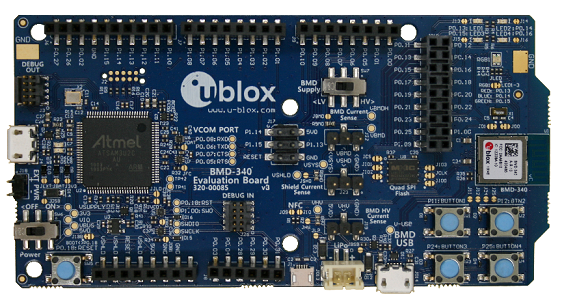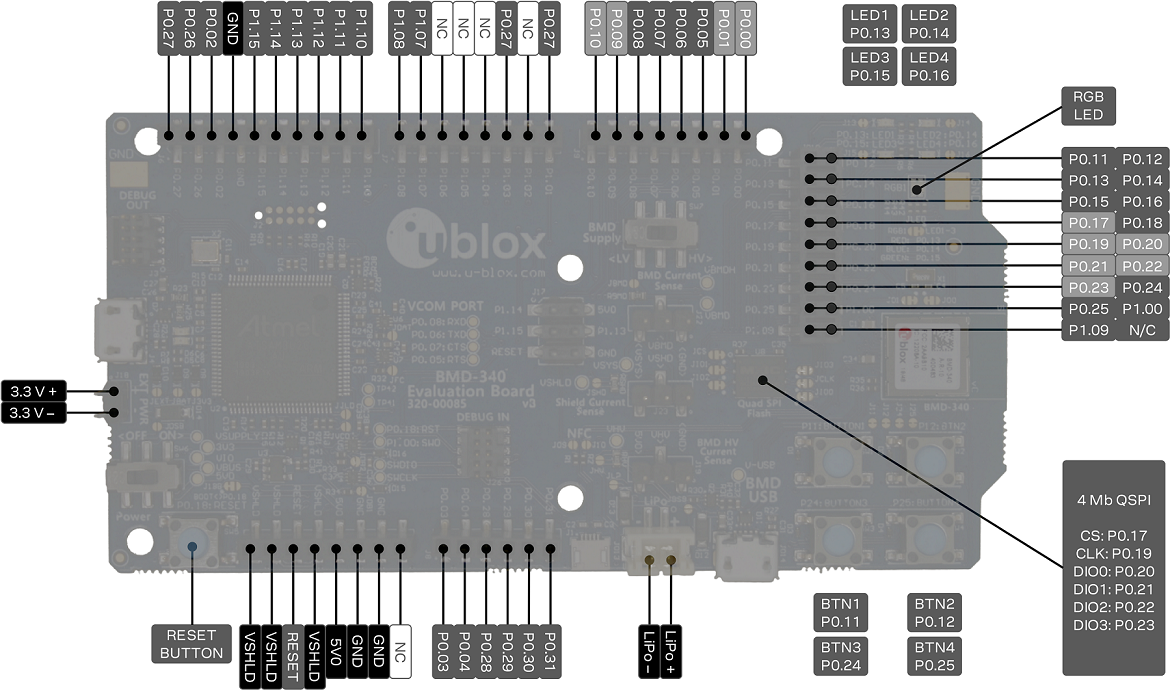u-blox EVK-BMD-34/38: BMD-340-EVAL and BMD-341-EVAL
Overview
The BMD-340-EVAL and BMD-341-EVAL hardware provides support for the u-blox BMD-340 and BMD-341 Bluetooth 5.0 modules, based on the Nordic Semiconductor nRF52840 ARM Cortex-M4F CPU. the BMD-340 and BMD-341 are identical in operation except for the antenna. The BMD-340 has a PCB antenna while the BMD-341 has a U.FL connector. Both support the following devices:
ADC
CLOCK
FLASH
GPIO
I2C
MPU
NVIC
PWM
RADIO (Bluetooth Low Energy and 802.15.4)
RTC
Segger RTT (RTT Console)
SPI
UART
USB
WDT

Fig. 173 BMD-340-EVAL (Credit: u-blox AG)
More information about the BMD-340-EVAL, BMD-340 module, BMD-341-EVAL, and BMD-341 module can be found at the u-blox website 1. All of the Nordic Semiconductor examples for the nRF52840 DK (nrf52840dk_nrf52840) may be used without modification.
- ..note::
The BMD-340 and BMD-341 are identical except for the antennna. Throughout this board support package, the filenames utilize the ubx_bmd340eval_nrf52840.
Hardware
The BMD-340 on the BMD-340-EVAL (or BMD-341 on the BMD-341-EVAL) contains an internal high-frequency oscillator at 32MHz. There is also a low frequency (slow) oscillator of 32.768kHz. The BMD-340 and BMD-341 do not include the slow crystal; however, the BMD-340-EVAL and BMD-341-EVAL do.
Note
When targeting a custom design without a slow crystal, be sure to modify code to utilize the internal RC oscillator for the slow clock.
Supported Features
The BMD-340-EVAL and BMD-341-EVAL board configuration supports the following hardware features:
Interface |
Controller |
Driver/Component |
|---|---|---|
ADC |
on-chip |
adc |
CLOCK |
on-chip |
clock_control |
FLASH |
on-chip |
flash |
GPIO |
on-chip |
gpio |
I2C(M) |
on-chip |
i2c |
MPU |
on-chip |
arch/arm |
NVIC |
on-chip |
arch/arm |
PWM |
on-chip |
pwm |
RADIO |
on-chip |
Bluetooth, IEEE 802.15.4 |
RTC |
on-chip |
system clock |
RTT |
Segger |
console |
SPI(M/S) |
on-chip |
spi |
UART |
on-chip |
serial |
USB |
on-chip |
usb |
WDT |
on-chip |
watchdog |
Other hardware features have not been enabled yet for this board. See the u-blox website 1 for a complete list of BMD-340-EVAL and BMD-341-EVAL hardware features.
Connections and IOs
LED
LED1 (red) = P0.13
LED2 (red) = P0.14
LED3 (green) = P0.15
LED4 (green) = P0.16
D5 (red) = OB LED 1
D6 (green) = OB LED 2
External Connectors

Note
The pin numbers noted below are referenced to the pin 1 markings on the BMD-340-EVAL or BMD-341-EVAL for each header
J-Link Prog Connector (J2)
PIN # |
Signal Name |
|---|---|
1 |
VDD |
2 |
IMCU_TMSS |
3 |
GND |
4 |
IMCU_TCKS |
5 |
V5V |
6 |
IMCU_TDOS |
7 |
Cut off |
8 |
IMCU_TDIS |
9 |
Cut off |
10 |
IMCU_RESET |
Debug OUT (J3)
PIN # |
Signal Name |
|---|---|
1 |
EXT_VTG |
2 |
EXT_SWDIO |
3 |
GND |
4 |
EXT_SWDCLK |
5 |
GND |
6 |
EXT_SWO |
7 |
N/C |
8 |
N/C |
9 |
EXT_GND_DETECT |
10 |
EXT_RESET |
Debug IN (J26)
PIN # |
Signal Name |
|---|---|
1 |
BMD-340_VCC |
2 |
BMD-340_SWDIO |
3 |
GND |
4 |
BMD-340_SWDCLK |
5 |
GND |
6 |
BMD-340_SWO |
7 |
N/C |
8 |
N/C |
9 |
GND |
10 |
BMD-340_RESET |
Auxiliary (J9)
PIN # |
Signal Name |
|---|---|
1 |
P0.10 / NFC2 |
2 |
P0.09 / NFC1 |
3 |
P0.08 |
4 |
P0.07 |
5 |
P0.06 |
6 |
P0.05 / AIN3 |
7 |
P0.01 / XL2 |
8 |
P0.00 / XL1 |
Auxiliary (J10)
PIN # |
Signal Name |
|---|---|
1 |
P0.11 / TRACED[2] |
2 |
P0.12 / TRACED[1] |
3 |
P0.13 |
4 |
P0.14 |
5 |
P0.15 |
6 |
P0.16 |
7 |
P0.17 / QSPI_CS |
8 |
P0.18 / RESET |
9 |
P0.19 / QSPI_CLK |
10 |
P0.20 / QSPI_D0 |
11 |
P0.21 / QSPI_D1 |
12 |
P0.22 / QSPI_D2 |
13 |
P0.23 / QSPI_D3 |
14 |
P0.24 |
15 |
P0.25 |
16 |
P1.00 / TRACED[0] |
17 |
P1.09 / TRACED[3] |
18 |
No connection |
Arduino Headers
Power (J5)
PIN # |
Signal Name |
BMD-34x Functions |
|---|---|---|
1 |
VSHLD |
N/A |
2 |
VSHLD |
N/A |
3 |
RESET |
P0.18 / RESET |
4 |
VSHLD |
N/A |
5 |
V5V |
N/A |
6 |
GND |
N/A |
7 |
GND |
N/A |
8 |
N/C |
N/A |
Analog in (J8)
PIN # |
Signal Name |
BMD-34x Functions |
|---|---|---|
1 |
A0 |
P0.03 / AIN1 |
2 |
A1 |
P0.04 / AIN2 |
3 |
A2 |
P0.28 / AIN4 |
4 |
A3 |
P0.29 / AIN5 |
5 |
A4 |
P0.30 / AIN6 |
6 |
A5 |
P0.31 / AIN7 |
Digital I/O (J7)
PIN # |
Signal Name |
BMD-34x Functions |
|---|---|---|
1 |
D7 |
P1.08 |
2 |
D6 |
P1.07 |
3 |
D5 |
P1.06 |
4 |
D4 |
P1.05 |
5 |
D3 |
P1.04 |
6 |
D2 |
P1.03 |
7 |
D1 (TX) |
P1.02 |
8 |
D0 (RX) |
P1.01 |
Digital I/O (J6)
PIN # |
Signal Name |
BMD-34x Functions |
|---|---|---|
1 |
SCL |
P0.27 |
2 |
SDA |
P0.26 |
3 |
AREF |
P0.02 / AIN0 |
4 |
GND |
N/A |
5 |
D13 (SCK) |
P1.15 |
6 |
D12 (MISO) |
P1.14 |
7 |
D11 (MOSI) |
P1.13 |
8 |
D10 (SS) |
P1.12 |
9 |
D9 |
P1.11 |
10 |
D8 |
P1.10 |
J11
PIN # |
Signal Name |
BMD-34x Functions |
|---|---|---|
1 |
D12 (MISO) |
P0.14 |
2 |
V5V |
N/A |
3 |
D13 (SCK) |
P0.15 |
4 |
D11 (MOSI) |
P0.13 |
5 |
RESET |
N/A |
6 |
N/A |
N/A |
Programming and Debugging
Applications for the BMD-340-EVAL and BMD-341-EVAL board configurations can be built and flashed in the usual way (see Building an Application and Run an Application for more details); however, the standard debugging targets are not currently available.
Flashing
Follow the instructions in the Nordic nRF5x Segger J-Link page to install and configure all the necessary software. Further information can be found in Flashing. Then build and flash applications as usual (see Building an Application and Run an Application for more details).
Here is an example for the Hello World application.
First, run your favorite terminal program to listen for output.
$ minicom -D <tty_device> -b 115200
Replace <tty_device> with the port where the BMD-340-EVAL
or BMD-341-EVAL can be found. For example, under Linux,
/dev/ttyACM0.
Then build and flash the application in the usual way.
# From the root of the zephyr repository
west build -b ubx_bmd340eval_nrf52840 samples/hello_world
west flash
Debugging
Refer to the Nordic nRF5x Segger J-Link page to learn about debugging u-blox boards with a Segger J-LINK-OB IC.
Using UART1
The following approach can be used when an application needs to use more than one UART for connecting peripheral devices:
Add device tree overlay file to the main directory of your application:
$ cat ubx_bmd340eval_nrf52840.overlay &uart1 { compatible = "nordic,nrf-uarte"; current-speed = <115200>; status = "okay"; tx-pin = <14>; rx-pin = <16>; };
In the overlay file above, pin P0.16 is used for RX and P0.14 is used for TX
Use the UART1 as
device_get_binding("UART_1")
Overlay file naming
The file has to be named <board>.overlay and placed in the app
main directory to be picked up automatically by the device tree
compiler.
Selecting the pins
To select the pin numbers for tx-pin and rx-pin:
tx-pin = <pin_no>
Open the data sheet for the BMD-340 at the u-blox website 1, Section 2 ‘Pin definition’. In the table 3 select the pins marked ‘GPIO’. Note that pins marked as ‘Standard drive, low frequency I/O only (<10 kH’ can only be used in under-10KHz applications. They are not suitable for 115200 speed of UART.
Translate ‘Pin’ into number for Device tree by using the following formula:
pin_no = b\*32 + a
where a and b are from the Pin value in the table (Pb.a).
For example, for P0.1, pin_no = 1 and for P1.0, pin_no = 32.